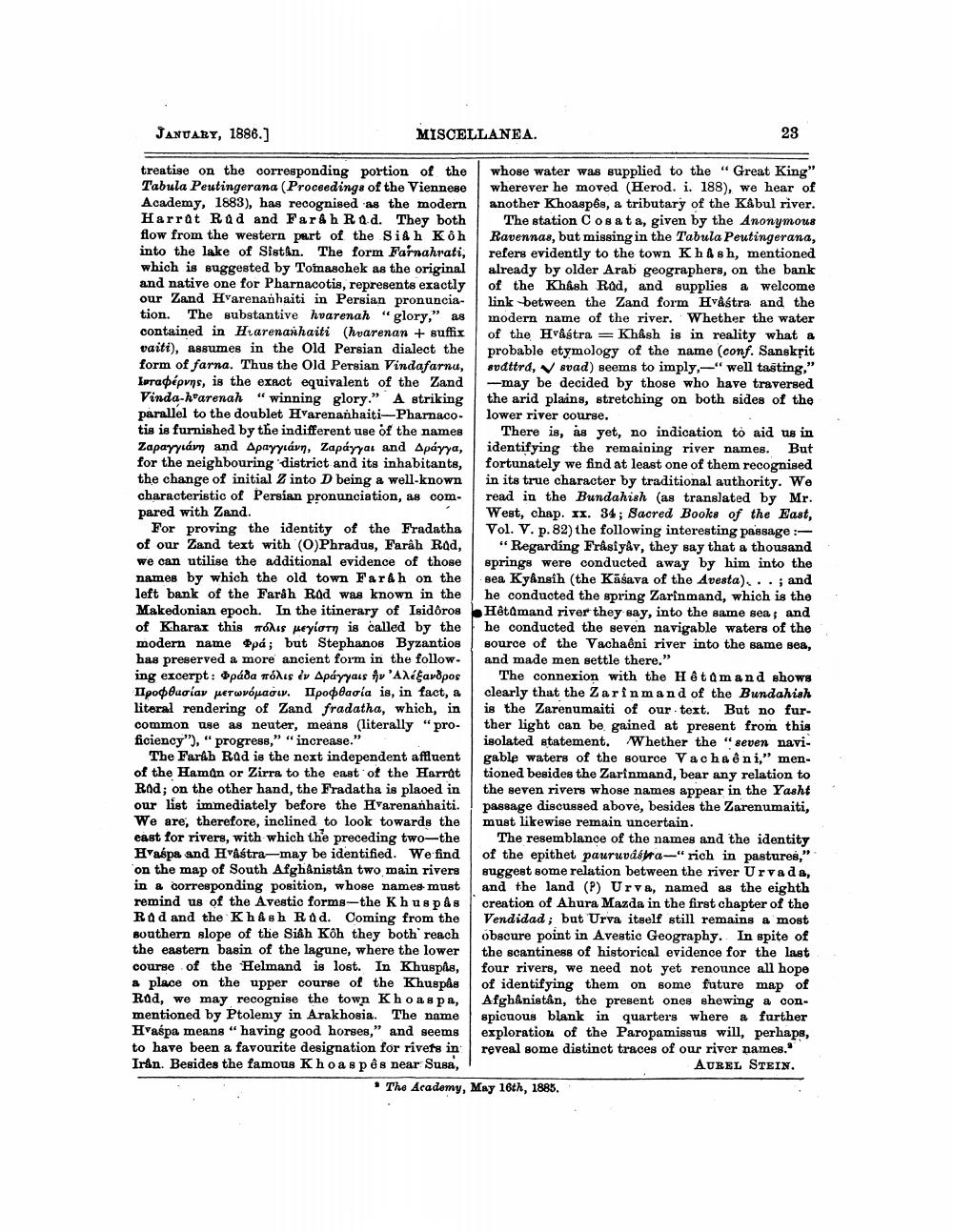________________
JANUARY, 1886.]
treatise on the corresponding portion of the Tabula Peutingerana (Proceedings of the Viennese Academy, 1883), has recognised as the modern Harrat Rad and Farah Rad. They both flow from the western part of the Si&h Köh into the lake of Sistin. The form Farnahrati, which is suggested by Tomaschek as the original and native one for Pharnacotis, represents exactly our Zand Hvarenanhaiti in Persian pronunciation. The substantive hvarenah " 'glory," as contained in Harenanhaiti (hvarenan + suffix vaiti), assumes in the Old Persian dialect the form of farna. Thus the Old Persian Vindafarnu, Καταφέρνης, is the exact equivalent of the Zand Vinda-h'arenah "winning glory." A striking parallel to the doublet Hvarenanhaiti-Pharmacotis is furnished by the indifferent use of the names Ζαραγγιάνη and Δραγγιάνη, Ζαράγγαι and Δράγγα, for the neighbouring district and its inhabitants, the change of initial Z into D being a well-known characteristic of Persian pronunciation, as compared with Zand.
MISCELLANEA.
For proving the identity of the Fradatha of our Zand text with (O)Phradus, Farâh Rad, we can utilise the additional evidence of those names by which the old town Farah on the left bank of the Farah Rad was known in the Makedonian epoch. In the itinerary of Isidôros of Kharax this πόλις μεγίστη is called by the modern name pá; but Stephanos Byzantios has preserved a more ancient form in the following excerpt: Φράδα πόλις ἐν Δράγγαις ἦν ̓Αλέξανδρος Προφθασίαν μετωνόμασιν. Προφθασία is, in fact, a literal rendering of Zand fradatha, which, in common use as neuter, means (literally "proficiency"), "progress," "increase."
The Farah Rad is the next independent affluent of the Haman or Zirra to the east of the Harrût Rad; on the other hand, the Fradatha is placed in our list immediately before the Hvarenanhaiti. We are, therefore, inclined to look towards the east for rivers, with which the preceding two-the Hvaspa and Hvâstra-may be identified. We find on the map of South Afghanistan two main rivers in a corresponding position, whose names must remind us of the Avestic forms-the Khus pås Rad and the Kh&sh Rad. Coming from the southern slope of the Sith Kôh they both reach the eastern basin of the lagune, where the lower course of the Helmand is lost. In Khuspas, a place on the upper course of the Khuspås Rad, we may recognise the town Khoas pa, mentioned by Ptolemy in Arakhosia. The name Hvaspa means "having good horses," and seems to have been a favourite designation for rivets in Irån. Besides the famous Khoa spês near Susa,
23
whose water was supplied to the "Great King" wherever he moved (Herod. i. 188), we hear of another Khoaspês, a tributary of the Kâbul river. The station Cos at a, given by the Anonymous Ravennas, but missing in the Tabula Peutingerana, refers evidently to the town Khash, mentioned already by older Arab geographers, on the bank of the Khâsh Rûd, and supplies a welcome link between the Zand form Hvâstra and the modern name of the river. Whether the water of the Hvâstra Khâsh is in reality what a probable etymology of the name (conf. Sanskrit svattrá, svad) seems to imply,-" well tasting," -may be decided by those who have traversed the arid plains, stretching on both sides of the lower river course.
There is, as yet, no indication to aid us in identifying the remaining river names. But fortunately we find at least one of them recognised in its true character by traditional authority. We read in the Bundahish (as translated by Mr. West, chap. xx. 34; Sacred Books of the East, Vol. V. p. 82) the following interesting passage:
"Regarding Frâsiyav, they say that a thousand springs were conducted away by him into the sea Kyânsih (the Kasava of the Avesta)... ; and he conducted the spring Zarinmand, which is the Hêtamand river they say, into the same sea; and he conducted the seven navigable waters of the source of the Vachaêni river into the same sea, and made men settle there."
The connexion with the Hêtamand shows clearly that the Zarinmand of the Bundahish is the Zarenumaiti of our text. But no further light can be gained at present from this isolated statement. Whether the "seven navigable waters of the source Vachaêni," mentioned besides the Zarinmand, bear any relation to the seven rivers whose names appear in the Yasht passage discussed above, besides the Zarenumaiti, must likewise remain uncertain.
The resemblance of the names and the identity of the epithet pauruvdéra-" rich in pastures," suggest some relation between the river Urvada, and the land (P) Urva, named as the eighth creation of Ahura Mazda in the first chapter of the Vendidad; but Urva itself still remains a most obscure point in Avestic Geography. In spite of the scantiness of historical evidence for the last four rivers, we need not yet renounce all hope of identifying them on some future map of Afghanistan, the present ones shewing a conspicuous blank in quarters where a further exploration of the Paropamissus will, perhaps, reveal some distinct traces of our river names." AUREL STEIN.
The Academy, May 16th, 1885.




